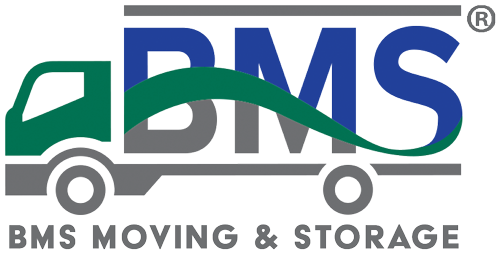- Moving Guides
- +1
- 6 Min Read
- Moving Guides
- Office Moving
- 6 Min Read
A Comprehensive Guide to a Smooth Commercial Move
-
Share

Change is inevitable in the world of business. Sometimes, that change involves relocating your entire operation to a new workspace. Whether you’re expanding, downsizing, or simply moving to a more strategic location, commercial relocations present unique challenges that require careful planning and execution.
At BMS Moving & Storage, we know the complexities involved in moving a business, and we’re here to guide you through the process. In our comprehensive guide, we explore the key aspects of commercial relocations and provide expert tips to ensure your move is as smooth and efficient as possible.
Curious to learn more about a full-service commercial move? Read our blog.
Planning Is The Foundation of a Successful Commercial Move
We can’t overstate the importance of thorough planning in a commercial relocation. Unlike residential moves, business relocations involve multiple stakeholders, complex logistics, and the potential for significant financial impact if not executed properly.
Key Planning Steps
- Establish a Moving Team: First, make sure to designate key personnel from each department to oversee their area’s move.
- Create a Detailed Timeline: Work backward from your desired move-in date, allowing ample time for each phase of the relocation.
- Inventory Everything: Conduct a thorough inventory of all assets, from office furniture to specialized equipment.
- Develop a Communication Plan: Ensure all employees, clients, and vendors are informed about the move and any potential disruptions.
- Budget Carefully: Account for all potential costs, including potential downtime and productivity loss.
Minimize Business Disruption: Strategies for Continuity
One of the biggest challenges in commercial relocations is maintaining business continuity. Here are some strategies to minimize disruption:
- Phase the Move: Consider moving departments or teams in stages to maintain some level of operations throughout the process.
- Utilize Off-Hours: Conduct major moving activities during evenings or weekends to minimize impact on regular business hours.
- Set Up Temporary Workspaces: Establish interim work areas for critical functions that need to remain operational during the move.
- Leverage Technology: Use cloud-based systems and remote work capabilities to keep operations running during the transition.
- Overcommunicate: Keep all stakeholders informed about the progress of the move and any changes to the timeline or process.
How to Safely Move Specialized Equipment and Protect Your Assets
Many businesses rely on specialized equipment that demands extra care and attention during a relocation. Ensuring these valuable assets arrive safely at your new location is crucial for a smooth transition and minimal downtime.
To achieve this, start by consulting with equipment manufacturers for specific moving and reinstallation instructions, as they can provide invaluable guidance on handling their products. For highly sensitive or valuable equipment, it’s worth considering specialized movers with expertise in transporting such items. Don’t skimp on packing materials, either. Invest in high-quality options designed specifically for delicate equipment to provide maximum protection during transit.
Lastly, for IT equipment, make sure all data is thoroughly backed up before the move to prevent any potential loss of critical information. By taking these precautions, you can significantly reduce the risk of damage to your specialized equipment and ensure it arrives at your new location ready for immediate use.
Coordinate with Multiple Departments to Ensure a Unified Approach
Large-scale commercial moves often involve coordinating across various departments, each with its own needs and concerns. Here’s how to manage this complexity:
- Regular Check-ins: Schedule frequent meetings with department representatives to track progress and address concerns.
- Standardized Processes: Develop standardized packing and labeling systems to be used across all departments.
- Department-Specific Plans: Work with each department to create tailored moving plans that address their unique needs.
- Cross-Department Cooperation: Encourage departments to assist each other and share resources where possible.
- Clear Chain of Command: Establish a clear decision-making hierarchy to resolve conflicts or issues quickly.

Getting Back to Business Quickly
The ultimate goal of any commercial relocation is to swiftly return to your full operational capacity, minimizing disruption to your business. Commercial relocations often involve logistical challenges that go beyond those of residential moves. Here’s how to manage these complexities:
- Parking and Access: Coordinate with building management at both locations to ensure adequate parking and access for moving trucks.
- Elevator Reservations: In multi-story buildings, reserve freight elevators well in advance for both move-out and move-in days.
- Security Considerations: Develop a plan to maintain the security of sensitive information and valuable assets throughout the move.
- Disposal and Recycling: Arrange for proper disposal or recycling of items that won’t be moved to the new location.
- Cleaning Services: Schedule deep cleaning services for both the old and new locations.
How to Involve Your Employees
Employees play a crucial role in the success of a commercial relocation. Here’s how to keep them engaged and positive:
- Clear Communication: Keep employees informed about the reasons for the move and how it will benefit the company and them personally.
- Involve Them in Planning: Solicit employee input on the new office layout and amenities.
- Provide Moving Guidelines: Offer clear instructions on what employees are responsible for in terms of packing and preparing for the move.
- Address Concerns: Be open to addressing any concerns or questions employees may have about the relocation.
- Celebrate the Move: Plan a small celebration or office warming event to mark the successful completion of the move!
Leveraging Technology in Commercial Relocations
Technology can significantly streamline commercial relocations. Move management software efficiently tracks inventory and timelines, while virtual tours help employees visualize their new workspace. Digital inventory systems ensure accurate item tracking, and project management tools keep stakeholders informed.
Early planning for system integration is crucial for moves to smart buildings. By embracing these technologies, companies can reduce complexity and ensure a smoother transition to their new location.
Post-Move Considerations to Ensure Long-Term Success
The work doesn’t end once you’ve moved into your new space! Here are some post-move considerations to keep in mind to get your organization back up and running quickly:
- Feedback Collection: Asking for feedback improves your process and shows you care. Gather feedback from employees about their moving experience and the new space.
- Fine-tuning: Be prepared to make adjustments to the layout or systems based on how they function in practice.
- Updated Marketing Materials: Make sure to update all company materials, including websites and business cards, with the new address.
- Client/Vendor Notifications: Follow up with clients and vendors to ensure they’re aware of your new location.
- Team Building: Consider team-building activities to help employees adjust to and feel comfortable in the new space.
Partnering with Professional Movers: The BMS Moving & Storage Advantage
While this guide provides a comprehensive overview of commercial relocations, partnering with experienced professional movers can make all the difference. At BMS Moving & Storage, we specialize in commercial relocations of all sizes and complexities.
Our team of experts can:
- Provide customized moving plans tailored to your specific business needs
- Offer specialized packing and moving services for sensitive equipment
- Coordinate all aspects of the move, from planning to post-move support
- Minimize downtime and disruption to your business operations
- Ensure the safety and security of your assets throughout the moving process
With over 120 years of experience in the moving industry, BMS Moving & Storage has the expertise and resources to make your commercial relocation a success. Our commitment to excellence and customer satisfaction sets us apart in the industry.
Embracing Change and Growth
A commercial relocation, while challenging, represents an exciting opportunity for growth and positive change for your business. By carefully planning each aspect of the move, minimizing disruptions, and partnering with experienced professionals, you can turn this complex process into a seamless transition to your new space.
Remember, the key to a successful commercial relocation lies in thorough preparation, clear communication, and the right support. Whether you’re moving across the street or across the country, BMS Moving & Storage is here to ensure your business gets where it needs to go, efficiently and securely.
Ready to start planning your commercial relocation? Contact BMS Moving & Storage today at 1.877.462.0213 or visit our website for a free quote. Let us help you navigate the complexities of your business move, so you can focus on what you do best–running your business. With BMS, you’re not just moving; you’re moving forward.



